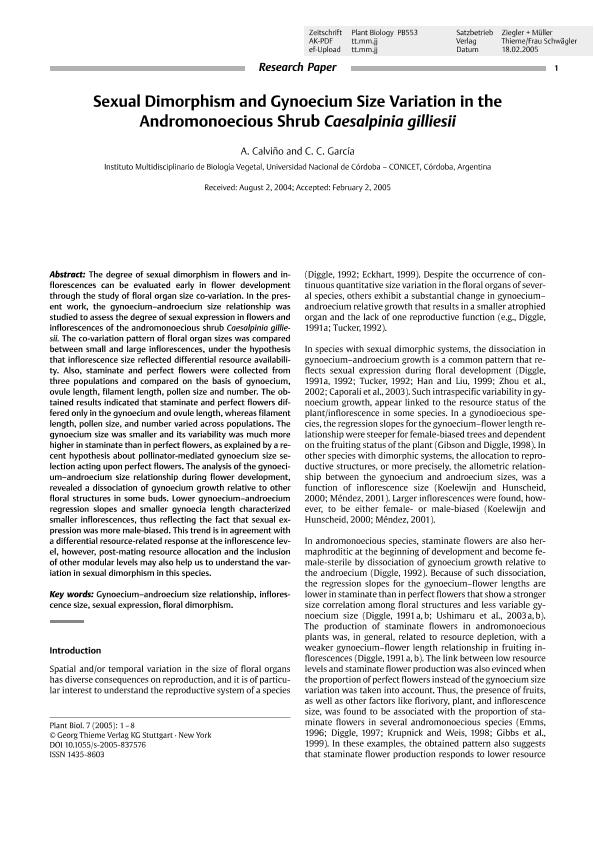Mostrar el registro sencillo del ítem
dc.contributor.author
Calviño, Ana Alejandra

dc.contributor.author
Carrizo Garcia, Carolina

dc.date.available
2018-02-19T17:44:14Z
dc.date.issued
2005-03
dc.identifier.citation
Calviño, Ana Alejandra; Carrizo Garcia, Carolina; Sexual dimorphism and gynoecium size variation in the andromonoecious shrub Caesalpinia gilliesii; Wiley Blackwell Publishing, Inc; Plant Biology; 7; 2; 3-2005; 195-202
dc.identifier.issn
1435-8603
dc.identifier.uri
http://hdl.handle.net/11336/36721
dc.description.abstract
The degree of sexual dimorphism in flowers and inflorescences can be evaluated early in flower development through the study of floral organ size co-variation. In the present work, the gynoecium-androecium size relationship was studied to assess the degree of sexual expression in flowers and inflorescences of the andromonoecious shrub Caesalpinia gilliesii. The co-variation pattern of floral organ sizes was compared between small and large inflorescences, under the hypothesis that inflorescence size reflected differential resource availability. Also, staminate and perfect flowers were collected from three populations and compared on the basis of gynoecium, ovule length, filament length, pollen size and number. The obtained results indicated that staminate and perfect flowers differed only in the gynoecium and ovule length, whereas filament length, pollen size, and number varied across populations. The gynoecium size was smaller and its variability was much higher in staminate than in perfect flowers, as explained by a recent hypothesis about pollinator-mediated gynoecium size selection acting upon perfect flowers. The analysis of the gynoecium-androecium size relationship during flower development, revealed a dissociation of gynoecium growth relative to other floral structures in some buds. Lower gynoecium-androecium regression slopes and smaller gynoecia length characterized smaller inflorescences, thus reflecting the fact that sexual expression was more male-biased. This trend is in agreement with a differential resource-related response at the inflorescence level, however, post-mating resource allocation and the inclusion of other modular evels may also help us to understand the variation in sexual dimorphism in this species.
dc.format
application/pdf
dc.language.iso
eng
dc.publisher
Wiley Blackwell Publishing, Inc

dc.rights
info:eu-repo/semantics/openAccess
dc.rights.uri
https://creativecommons.org/licenses/by-nc-sa/2.5/ar/
dc.subject
Floral Dimorphism
dc.subject
Gynoecium-Androecium Size Relationship
dc.subject
Inflorescence Size
dc.subject
Sexual Expression
dc.subject.classification
Otras Ciencias Biológicas

dc.subject.classification
Ciencias Biológicas

dc.subject.classification
CIENCIAS NATURALES Y EXACTAS

dc.title
Sexual dimorphism and gynoecium size variation in the andromonoecious shrub Caesalpinia gilliesii
dc.type
info:eu-repo/semantics/article
dc.type
info:ar-repo/semantics/artículo
dc.type
info:eu-repo/semantics/publishedVersion
dc.date.updated
2018-02-14T19:30:26Z
dc.identifier.eissn
1438-8677
dc.journal.volume
7
dc.journal.number
2
dc.journal.pagination
195-202
dc.journal.pais
Reino Unido

dc.journal.ciudad
Londres
dc.description.fil
Fil: Calviño, Ana Alejandra. Consejo Nacional de Investigaciones Científicas y Técnicas. Centro Científico Tecnológico Conicet - Córdoba. Instituto Multidisciplinario de Biología Vegetal. Universidad Nacional de Córdoba. Facultad de Ciencias Exactas Físicas y Naturales. Instituto Multidisciplinario de Biología Vegetal; Argentina
dc.description.fil
Fil: Carrizo Garcia, Carolina. Consejo Nacional de Investigaciones Científicas y Técnicas. Centro Científico Tecnológico Conicet - Córdoba. Instituto Multidisciplinario de Biología Vegetal. Universidad Nacional de Córdoba. Facultad de Ciencias Exactas Físicas y Naturales. Instituto Multidisciplinario de Biología Vegetal; Argentina
dc.journal.title
Plant Biology

dc.relation.alternativeid
info:eu-repo/semantics/altIdentifier/url/http://onlinelibrary.wiley.com/doi/10.1055/s-2005-837576/abstract
dc.relation.alternativeid
info:eu-repo/semantics/altIdentifier/doi/http://dx.doi.org/10.1055/s-2005-837576
Archivos asociados
